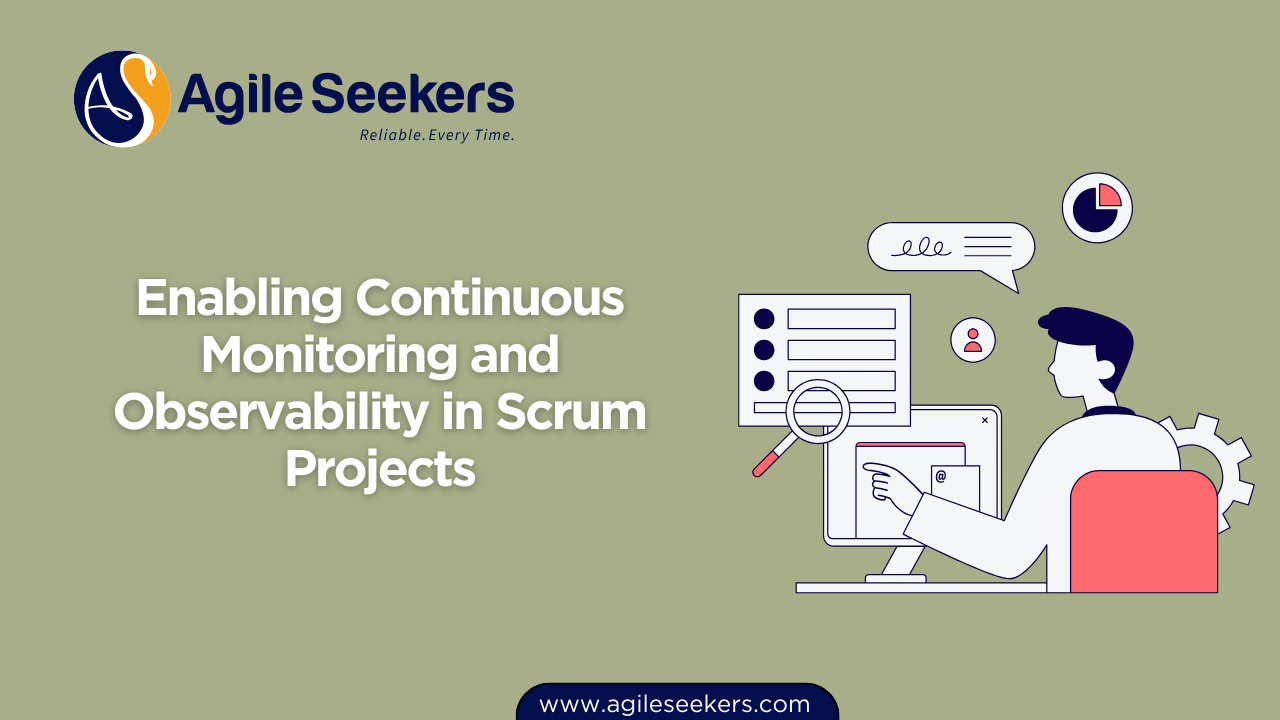Enabling Continuous Monitoring and Observability in Scrum Projects

Scrum teams deliver incremental value through short development cycles. However, consistent delivery alone doesn’t guarantee quality or stability. To build high-performing products, teams must detect issues early, trace root causes efficiently, and understand how features perform in production. This is where continuous monitoring and observability become essential for Scrum projects.
Integrating observability practices into the Scrum framework allows teams to move from reactive firefighting to proactive problem-solving. In this post, we’ll break down how Scrum teams can implement observability and continuous monitoring, the tools they can use, and how these practices align with certified scrum master training principles.
What Is Continuous Monitoring?
Continuous monitoring refers to the automated, ongoing collection of metrics, logs, and events from software systems. It helps teams track system health, performance, and availability in real-time. Key metrics may include:
- CPU and memory usage
- Latency and throughput of APIs
- Error rates and failed transactions
- Infrastructure uptime and incident alerts
These metrics help developers and operations teams identify bottlenecks, bugs, and anomalies without waiting for end-user reports or production outages.
What Is Observability?
Observability goes a step beyond monitoring. While monitoring tells you that something is wrong, observability helps you understand why it's wrong. It involves three core pillars:
- Metrics: Quantitative measurements like CPU usage or response time
- Logs: Timestamped records of events for traceability
- Traces: End-to-end paths that a request takes through microservices
With a solid observability strategy, teams can correlate failures across systems, pinpoint root causes quickly, and continuously improve software resilience.
Why Scrum Teams Should Care About Monitoring and Observability
Scrum is built on transparency, inspection, and adaptation. These core pillars align directly with continuous monitoring and observability:
| Scrum Principle | How Monitoring & Observability Supports It |
|---|---|
| Transparency | Exposes the current state of the system and services in real-time |
| Inspection | Lets teams examine production behaviors and performance metrics |
| Adaptation | Empowers rapid response to issues and informed iteration planning |
Scrum teams that adopt observability practices gain faster feedback loops, higher system reliability, and improved sprint retrospectives.
Incorporating Monitoring into Scrum Events
Sprint Planning
During sprint planning, monitoring dashboards and previous incident reports can help teams decide what technical debt or operational issues to address. If production metrics show consistent API latency, a story can be created to improve performance.
Daily Scrum
Daily stand-ups can include a quick check on key system health indicators. If a spike in error rate occurred overnight, it becomes part of the day’s discussion and prioritization.
Sprint Review
During reviews, teams can show not only new features but also CSM certification-aligned improvements in stability, response times, or uptime—using graphs and real-time dashboards.
Sprint Retrospective
Observability data supports factual discussions during retrospectives. For example, a spike in CPU usage correlating with a deployment helps teams assess if their deployment strategy needs refinement.
Key Tools for Monitoring and Observability
Scrum teams can integrate various tools into their development and CI/CD pipelines. Some widely used tools include:
- Prometheus for system metrics
- Grafana for dashboard visualization
- ELK Stack (Elasticsearch, Logstash, Kibana) for log management
- OpenTelemetry for distributed tracing
- Sentry for error monitoring
- Datadog for full-stack observability
By integrating these tools with your CI/CD pipelines, teams gain end-to-end visibility across the development lifecycle.
Observability as a Definition of Done Criterion
One way to institutionalize monitoring is to make it part of the Definition of Done (DoD). A feature isn’t considered complete unless it includes:
- Relevant logs that aid in debugging
- Custom metrics specific to business outcomes
- Alert thresholds for abnormal behavior
This approach aligns with the practices taught in both CSM certification training and SAFe Scrum Master training.
Real-World Use Case
Consider a team developing a payments API in a Scrum framework. Without observability, a delay in processing might only be noticed by users. But with end-to-end tracing, the team can identify that a new database query introduced in Sprint 5 caused a 200ms delay under high load. This insight helps them fix the issue in Sprint 6 proactively.
Collaboration Between Developers and Ops
While Scrum focuses on development, effective monitoring demands collaboration with operations and security. This is especially true in SAFe environments, where Scrum Masters often coordinate cross-functional alignment across the ART (Agile Release Train).
Practices like shared dashboards, joint sprint reviews with ops teams, and using incident data in retrospectives help bridge gaps and foster continuous improvement.
Common Pitfalls to Avoid
- Ignoring alert fatigue—too many alerts reduce response effectiveness
- Focusing only on infrastructure metrics without business context
- Neglecting traceability in microservice environments
- Failing to make monitoring actionable—dashboards should drive decisions
Final Thoughts
Scrum teams don’t need to wait for problems to surface in production. By enabling continuous monitoring and observability, teams strengthen their ability to deliver value reliably and with confidence. These practices enhance transparency, reduce risk, and empower data-driven decision-making—fundamentals also emphasized in SAFe Scrum master certification and CSM training.
To successfully implement observability, teams should start small: add basic metrics, create alert thresholds, and review logs as part of sprint retros. From there, evolve practices based on outcomes, team maturity, and business needs.
Investing in these capabilities not only enhances delivery but creates the groundwork for scalable, resilient systems. It also sets Scrum teams apart as not just delivery units—but product stewards focused on long-term quality and customer satisfaction.
Also read - Using Static Code Analysis Tools as Part of Sprint Reviews
Also see - Collaborating with DevOps to Streamline Deployment Pipelines




















